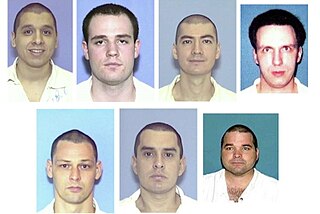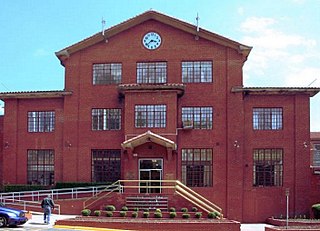
The Texas 7 were a group of prisoners who escaped from the John B. Connally Unit near Kenedy, Texas, on December 13, 2000. Six of the seven were apprehended over a month later, between January 22–24, 2001, as a direct result of the television show America's Most Wanted. The seventh committed suicide before he could be arrested. The surviving members were all convicted and sentenced to death for the murder of Irving, Texas, police officer Aubrey Wright Hawkins, who was shot and killed when responding to a robbery perpetrated by the Texas Seven. Four of the six sentenced have since been executed.

Capital punishment is a legal punishment under the criminal justice system of the United States federal government. It is the most serious punishment that could be imposed under federal law. The serious crimes that warrant this punishment include treason, espionage, murder, large-scale drug trafficking, or attempted murder of a witness, juror, or court officer in certain cases.
Capital punishment is a legal penalty in the U.S. state of Oklahoma.
Gregg v. Georgia, Proffitt v. Florida, Jurek v. Texas, Woodson v. North Carolina, and Roberts v. Louisiana, 428 U.S. 153 (1976), is a landmark decision of the U.S. Supreme Court. It reaffirmed the Court's acceptance of the use of the death penalty in the United States, upholding, in particular, the death sentence imposed on Troy Leon Gregg. The set of cases is referred to by a leading scholar as the July 2 Cases, and elsewhere referred to by the lead case Gregg. The court set forth the two main features that capital sentencing procedures must employ in order to comply with the Eighth Amendment ban on "cruel and unusual punishments". The decision essentially ended the de facto moratorium on the death penalty imposed by the Court in its 1972 decision in Furman v. Georgia 408 U.S. 238 (1972). Justice Brennan dissent famously argued that "The calculated killing of a human being by the State involves, by its very nature, a denial of the executed person's humanity... An executed person has indeed 'lost the right to have rights."

Capital punishment is a legal penalty in the U.S. state of Texas for murder, and participation in a felony resulting in death if committed by an individual who has attained or is over the age of 18.

The Brownstone Lane murders were the mass murders of four people at a residence on Brownstone Lane in Houston, Texas. On June 20, 1992, three men tied up six people and shot all of them in the head execution-style. Four of the six victims died. The perpetrators: Marion Butler Dudley, Arthur "Squirt" Brown Jr., and Antonia "Tony" Lamone Dunson were convicted of capital murder. Dudley and Brown were sentenced to death, while Dunson was sentenced to life in prison.
Capital punishment in Connecticut formerly existed as an available sanction for a criminal defendant upon conviction for the commission of a capital offense. Since the 1976 United States Supreme Court decision in Gregg v. Georgia until Connecticut repealed capital punishment in 2012, Connecticut had only executed one person, Michael Bruce Ross in 2005. Initially, the 2012 law allowed executions to proceed for those still on death row and convicted under the previous law, but on August 13, 2015, the Connecticut Supreme Court ruled that applying the death penalty only for past cases was unconstitutional.
Capital punishment was abolished in Colorado in 2020. It was legal from 1974 until 2020 prior to it being abolished in all future cases.

Allan B. Polunsky Unit is a prison in West Livingston, unincorporated Polk County, Texas, United States, located approximately 5 miles (8.0 km) southwest of Livingston along Farm to Market Road 350. The Texas Department of Criminal Justice (TDCJ) operates the facility. The unit houses the State of Texas death row for men, and it has a maximum capacity of 2,900. Livingston Municipal Airport is located on the other side of FM 350. The unit, along the Big Thicket, is 60 miles (97 km) east of Huntsville.

O. B. Ellis Unit is a Texas Department of Criminal Justice prison located in unincorporated Walker County, Texas, 12 miles (19 km) north of Huntsville. The unit, with about 11,427 acres (4,624 ha) of space, now houses up to 2,400 male prisoners. Ellis is situated in a wooded area shared with the Estelle Unit, which is located 3 miles (4.8 km) away from Ellis. From 1965 to 1999 it was the location of the State of Texas men's death row.
Humberto Leal García Jr. was a Mexican national who was sentenced to death in the US state of Texas for the May 21, 1994, rape, torture, and murder of Adria Sauceda in San Antonio. Despite calls from US President Barack Obama, the US State Department, and Mexico to Texas for a last-minute reprieve, Leal was executed as scheduled on July 7, 2011.
Capital punishment is a legal penalty in the U.S. state of North Carolina.
Elroy Chester was an American serial killer who committed five murders in Texas. He was convicted and sentenced to death for one of the murders, and was executed in 2013.

Suzanne Margaret "Sue" Basso was an American woman who was one of six co-defendants convicted in the August 1998 torture and murder of 59 year-old Louis "Buddy" Musso, a mentally disabled man who was killed for his life insurance money. She was sentenced to death in October 1999. Basso was executed by lethal injection on February 5, 2014. Prior to her execution, Basso had been held at the Mountain View Unit in Gatesville, Texas, where all of the state's female death row inmates are incarcerated. At the time of the crime, Basso lived in Jacinto City, Texas, a Houston suburb.
Nicolas "Nico" Anthony LaHood is a former criminal district attorney of Bexar County, Texas.
Capital punishment in Delaware was abolished after being declared unconstitutional by the Delaware Supreme Court on August 2, 2016. The ruling retroactively applies to earlier death sentences, and remaining Delaware death row inmates had their sentences commuted to life imprisonment. Despite this, the capital statute for first-degree murder under Title 11, Chapter 42, Section 09, of the Delaware Code has yet to be repealed, though it is unenforceable.

Gustavo Julian Garcia Jr. was an American prisoner from McKinney, Texas, who was executed for the 1990 murder of Craig Turski.
The Texas law of parties states that a person can be criminally responsible for the actions of another in certain circumstances, including "[i]f in the attempt to carry out a conspiracy to commit one felony, another felony is committed by one of the conspirators, all conspirators are guilty of the felony actually committed, though having no intent to commit it, if the offense was committed in furtherance of the unlawful purpose and was one that should have been anticipated as a result of the carrying out of the conspiracy."
Thomas Bartlett Whitaker is an American convicted under the Texas law of parties of murdering two family members as a 23-year-old. Whitaker was convicted on December 10, 2003, for the murders of his mother and 19-year-old brother; he was sentenced to death in March 2007. He spent years on death row at the Polunsky Unit near Livingston, Texas, before the commutation of his sentence.








